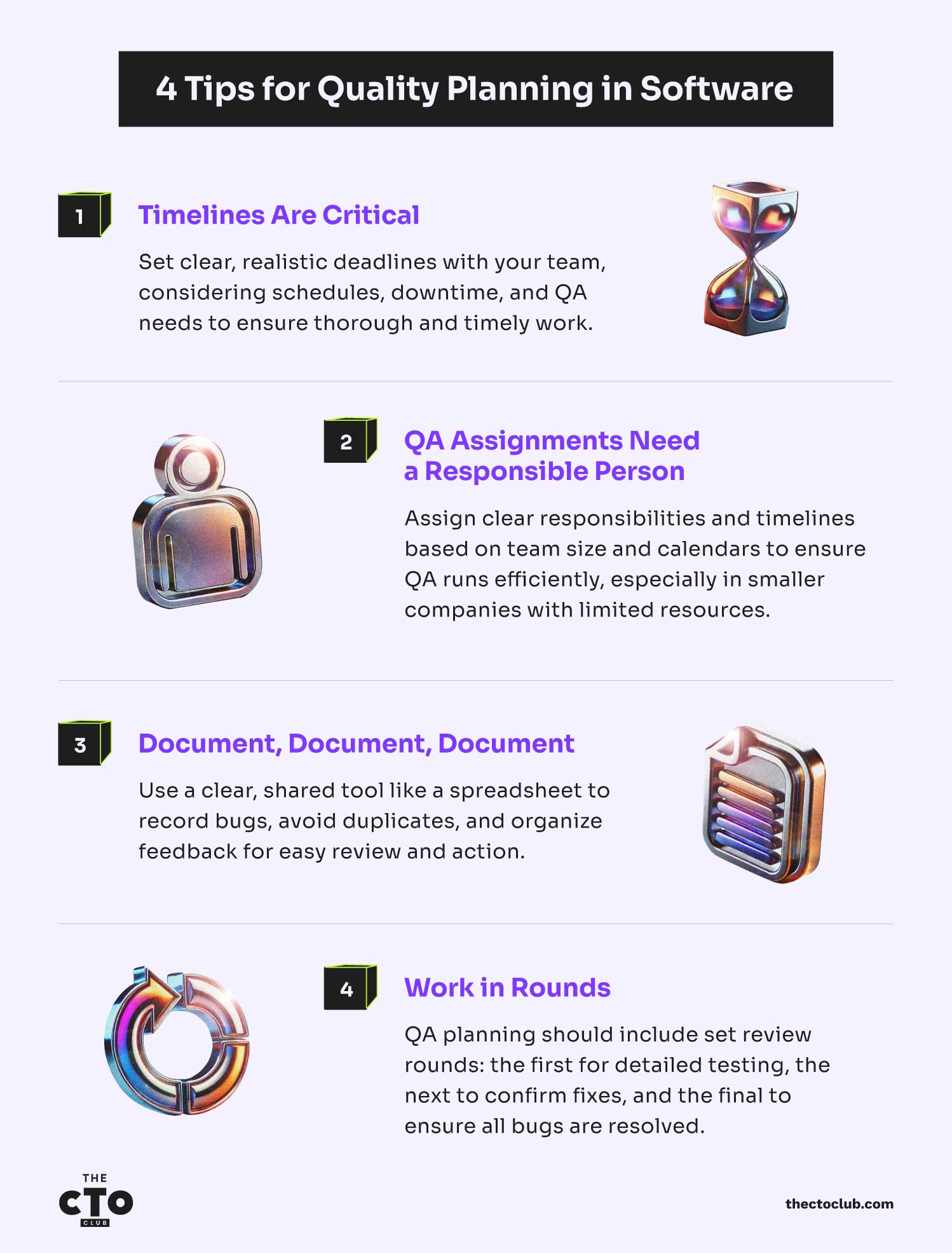In software, you need solid quality planning to release great products and services. Without it, you open the door to a host of issues that can be costly to the company’s bottom line and its reputation.
Poor quality planning or a lack of a succinct plan leads to production and release delays, budget overages, and a stain on the business's reputation. If you are heading up the quality assurance team, you should always be asking:
- How can we improve QA efficiency?
- How do we make sure that all functionalities and requirements are met?
Quality planning will help you answer those questions.
Searching for bugs that damage a product is no simple feat. Testing to ensure everything works as it should and is functioning to its full potential is where your central mandate lies.
Along with software testing, though, you may have the opportunity to offer suggestions on new design elements to make a product better. This is secondary to the main focus and is not as critical, especially if there are hard budget restrictions and deadlines. In that case, these things should be noted to be addressed later.
That said, your software quality management plan should encompass advanced quality planning, even if presented at different times, to refer to the difference between planned and actual performance.
4 Tips For Quality Planning in Software

1. Timelines Are Critical
Everyone works at a different pace, but quality planning must have hard deadlines outlined by the team. You can’t work on your procedures and techniques on your own schedule. The whole product team will have opinions about the timing that works best for everyone involved. It’s not ok to announce an expected release deadline only to have quality assurance get behind because they haven’t checked the calendar.
Be aware of downtime, such as holidays or weekends, as well as your team’s work schedule. If you have more than one product in the hopper for quality assurance, make sure there is enough time available to do your job thoroughly and precisely. Turnaround time should be reasonable. Make sure the timelines are clear to all involved, especially to your QA team.
2. QA Assignments Need a Responsible Person
These assignments vary depending on the size of the company. Using advanced product quality planning means you know what is coming, and you can get your team in place before the product shows up. Whether one person does QA in your company or a whole team, everyone needs to know the plan to make it work efficiently.
Designate who is responsible for what and what their timelines are. This is important in small companies as there are fewer people to share the workload, which means timelines and QA assignments have to be clear and respected. Limited people means limited flexibility. Assignments have to align not only with the team calendar but the assigned person’s work calendar as well.
3. Document, Document, Document
Write everything down. Quality control planning has to include a tool that makes it easy for your team to record bugs easily, coherently, and in a unified way. Using a spreadsheet is a simple way to do this. It offers flexibility to not only record bugs but also to make recommendations for changes. You want these lists to be clear so others can easily address them through feedback.
Using a spreadsheet allows the QA team leads to go through everyone’s input and make sure there are no redundant comments. Issues are grouped as needed, and the notes are easy to understand.
4. Work in Rounds
When putting quality planning together, QA should have a set number of rounds to review and revise. The first round is the most critical as it will look at the minutia of the product. Each part is tried and tested thoroughly. Once this first round is complete and the bugs addressed, the team retests the product to make sure the bugs don’t reappear before moving on to the next round. The final round should do a thorough test of all aspects of the product with final confirmation that all bugs have been taken care of.
Bulletproof Quality Planning Checklist
Start:
- Build your QA team.
- Set QA process.
- Choose how the team will note data collection (document planning).
Kick-off:
- Set the project's QA timeline that accounts for the product release timeline.
- Name team members. No matter the size of the team, availability and workload is essential to make sure timelines can be met without undue pressure.
Pre-Launch (Implementation):
- Start test rounds. The initial round should be thorough and detailed—double and triple-check.
- Make sure all bugs are recorded in the tool you have chosen for notation.
- Make a note of any recommendations for future discussions and amendments.
- Review bugs and recommendation lists to eliminate repeat comments and ensure the notes are clear for the team that will fix the bugs.
- Do rounds 2 and 3 to test for prior bugs and final clearance.
Post-Launch (Assessment):
- Gather feedback from users, sales, and other stakeholders.
- Discuss the next steps to implement feedback as needed and look at phase two recommendations that came from the first rounds of testing.
Final Thoughts
Quality planning is vital to product success, no matter the industry. Industries change as new testing technology becomes available and innovative products hit the market. Staying up-to-date makes sure your QA is bulletproof.
Sign up for our newsletter at The QA Lead or follow other QA experts and influencers to stay in the loop.



